
Classification of garden iris
While the basis for a botanical classification is the natural affinity of species, the underlying principles of horticultural classifications are simplicity and convenience, with plants' relationship being often ignored.
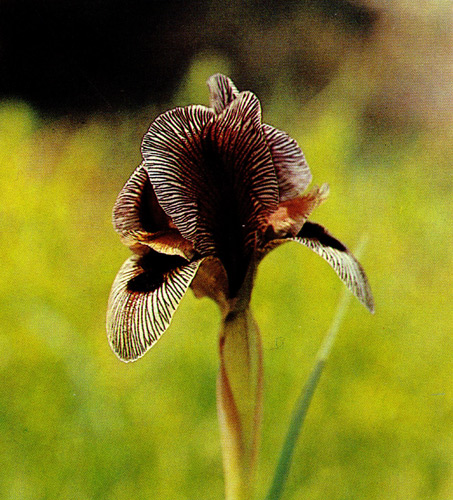
18. Iris grossheimii
There is no generally accepted classification of garden iris yet. In the foreign floricultural literature iris are divided into 13 groups in one case, and into 17 in the other. In "World of Irises" published by the American Iris Society in 1978, garden iris were divided into 17 groups. Without sacrificing its basic principle, this scheme can be simplified by excluding bulbous iris which belong to the independent genera Xiphium, Juno and Iridodictium.
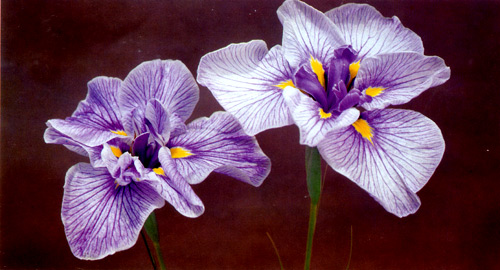
19. Japanese iris 'Expromt'
For the sake of simplicity, all iris cultivars and species with beards on the falls and without arils on the seeds can be brought together into one major group. As a result, the classification becomes simpler and more convenient, with all garden iris falling into 10 groups:
1. Bearded Iris.
2. Aril and Arilbred Iris.
3. Louisiana Iris.
4. Pacific Coast Iris.
5. Siberian Iris.
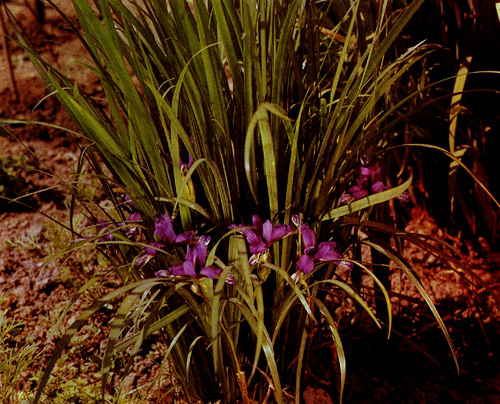
20. Iris graminea
6. Spuria Iris.
7. Hanashobu, or Japanese Iris.
8. Evancia Iris.
9. Reblooming Iris.
10. Lesser Known Iris.
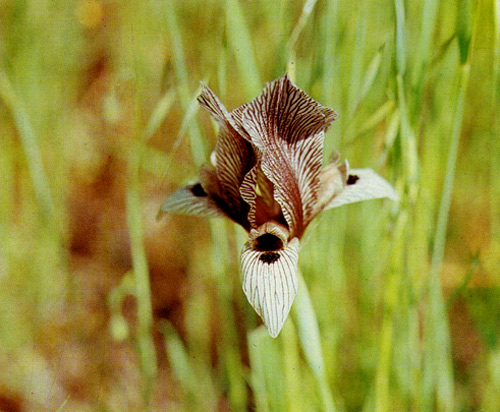
21. Iris ewbankiana
The group of bearded iris, which is the source of the diversity of the garden assortment, is the most difficult to classify. In attempts to study innumerable cultivars in this group several classifications were put forward. According to the most popular one, the iris are assigned to 6 classes, depending on the stalk height.
Short-stemmed cultivars are divided into 2 classes: 1. The so-called Miniature Dwarf Beardeds (MDB) with flower stalks up to 25 cm tall, carrying one or, rarely, two flowers, ealiest to bloom, and 2. Standard Dwarf Beardeds (SDB) with 25-to 35-cm stalks, bearing 2 or 3 flowers.
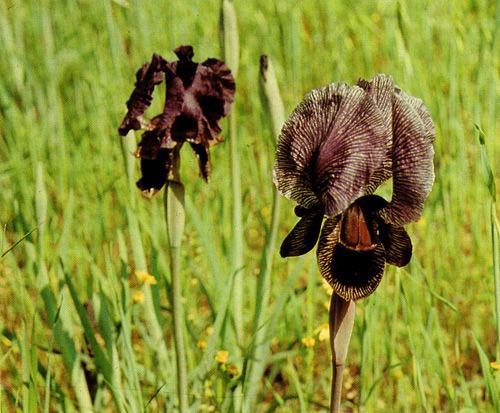
22. Iris lycotis
The three classes of intermediate bearded iris are: 1. Intermediate Beardeds (IB), the earliest flowering cultivars with 37-to 70-cm stalks and 7.5-to 12.5-cm flowers; 2. The so-called Miniature Tall Beardeds (MTB) with stalks as tall as the Intermediate Beardeds and 5-to 7.5 cm flowers; they are also called "Table iris", and 3. Border Beardeds (BB), late flowering, with 38-to 70-cm stalks and flowers 7.5 to 12 cm or more across. Finally, all cultivars of bearded iris taller than 70 cm and with flower width over 12.5 cm are referred to as Standard Tall Beardeds (STB).

23. The garden of a Japanese breeder
The classification adopted in the USSR is more simple and convenient, according to which bearded cultivars form 3 groups:
1. Dwarf iris, with 25-to 37-cm stalks;
2. Intermediate iris, with 37-to 70 cm stalks, and
3. Tall iris, with stalks 70cm tall and more.
Within these groups the cultivars are classified by the blooming time and flower colour.
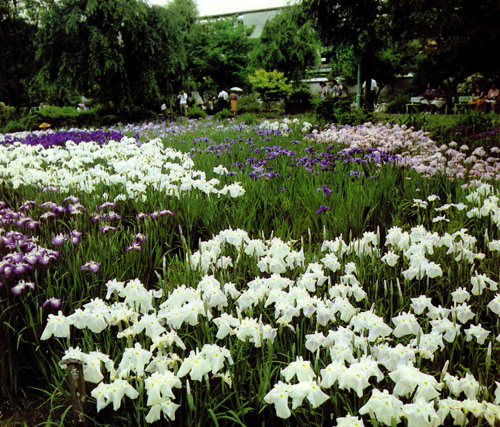
24. A park in Tokyo
Among the bearded iris are not uncommon the cultivars that have one colour for the standards and falls but the latter being of a deeper shade. They are bitones. There is a large number of dichromatic cultivars with the standards of one colour and the falls of another. These are termed bicolors. The cultivars with carmine-red falls and yellow standards are called Variegatas. Those having light or pure white standards and blue, violet and reddish falls are Amoenas. Sometimes, the edges of the perianth segments are of more intensive or different colouring. Such cultivars are named Plicatas. In recent years numerous cultivars of the Blends group have been developed. The colours in their petals transit from one tone to another inperceptibly.
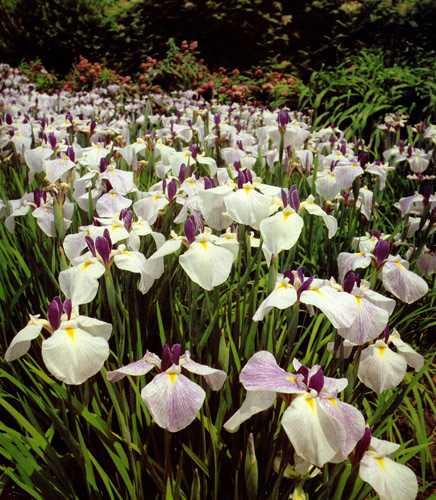
25. Japanese iris 'Machi Muzimi'
The Siberian, Japanese and Spuria iris are described in the section "Naturally Occurring Iris Species of the USSR"
The next group of iris (Arils and Arilbreds) is a mixed one, comprising species of four botanical sections, Hexapogon, Regelia, Psammiris and Oncocyclus. The characteristic feature of this group is distinct light arils on the seeds. The group includes also hybrid forms and cultivars resulting from remote hybridization between the species of the above sections and between the iris of one of the sections and species and cultivars of the bearded iris.

26. A corner in the Tokyo park
The Louisiana iris belong to the sub-genus Limniris. The progenitors of garden Louisiana iris are four North-American species naturally occurring in the Mississippi Delta in Louisiana. One of them, I. fulva, the only wild species with terracotta petals, is of special interest to iris breeders.
Cultivation of Louisiana iris started 40 or 50 years ago. Unfortunately, these iris have escaped the attention of Soviet breeders, although among the recent Louisiana hybrids there are cultivars with fragrant light-yellow, deep purple-violet and purple-blew flowers.
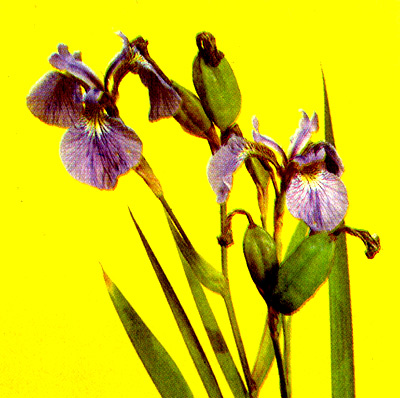
27. Iris setosa
The Pacific Coast iris, similarly to the preceeding group, originate in North America. Ten botanical species form the basis of this group, which has been brought into cultivation quite recently. These are small compact plants with stiff solid rhizomes and narrow grassy foliage. Lee Lentz, a botanist, made an extremely interesting observation, i. e. these American iris could be crossed with our Siberians. Thus, the cultivar 'Margot Holmes' arose which in 1927 won the Dykes Medal, top award bestowed on iris cultivars. The hybrids resulting from such remote crosses were named Cal-Sibes as the majority of the Pacific Coast species belong to subsection Californicae.

28. Iris kaempferi
The Pacific Coast iris are exacting as to light, prefer neutral dry and well-drained soils. They start flowering 2 or 3 weeks earlier than the Siberians do. Hybrid seedlings of Cal-Sibes iris with bright colouring and tender flower structure resemble orchids.
Reblooming iris flower both in spring and autumn.
Systematic selection of these iris has recently begun in the USA. In southern states first exhibitions were held, and encouraging prizes instituted, and first reblooming cultivars registered. In 1967 a group of fanciers set up the Reblooming Iris Society. Special sections were established at the Iris Societies in England and Italy. Initially, reblooming forms were selected from tall bearded iris, then arose the cultivars from the intermediate beardeds. However, the work with reblooming iris has been confined so far only to southern regions with warm climate. In the USSR these iris can be grown primarily on the Black Sea coast of the Caucasus and, possibly, in the Crimea where autumn-blooming irises are most desirable.

29. 'Vasilij Alferov'
The Evancias are not very popular because of their subtro-picality. Some of them are cultivated in the subtropics of the Black Sea coastal area.
The last group conventionally referred to as "Lesser Known Iris" comprises promising but at present little utilized species. The number of these is practically unlimited. Here belong species of sub-genus Limniris. Of special interest to the Soviet gardners are I. lazica which grows near Batumi, and I. unguicularis which was once brought to the south coast of the Crimea and then grew wild in the parks there. The two species start blooming in December or in late winter when the weather is rather warm. To this group also belong I. verna and I. rustica with short stems and grassy foliage, good for rock gardens, and I. pseudacorus and I. laevigata suitable for growing around ponds.

30. Iris carthaliniae
|
ПОИСК:
|
© FLOWERLIB.RU 2001–2022
При использовании материалов активная ссылка обязательна:
http://flowerlib.ru/ 'Библиотека по цветоводству'
При использовании материалов активная ссылка обязательна:
http://flowerlib.ru/ 'Библиотека по цветоводству'